The Pittsburgh Steelers are now 8-3, in a rough loss in a sloppy and snowy game against the (3-8) Cleveland Browns, the worst in the AFC North. There were a host of issues across the board, too many self-inflicted, culminating in dropping this winnable game that was frustrating to watch.
A couple of notes before we jump in. Thanks to Thomas Mock for his great work that helped me learn much of what I’m using in the series visually. Spikes and clear throwaways are removed due to being the correct situational decision, along with bats at the line of scrimmage. Three throwaways were removed, and a two-point conversion was added.
While not perfect, QB Russell Wilson was a bright spot overall as a passer. 21/28 on the stat sheet (75 percent), an even better 84.0 rate with throwaways removed, and a nice rate in the elements. The offensive line was below the line, allowing 17 pressures, several hits, and four sacks.
Despite all this, 270 pass yards tied for his second-most in 2024. Three big-time throws (T-season-high), four explosive passes, and a TD. 11.8 average distance of target and 9.6 yards per attempt tied for his second-most as well, and even had his best 116.7 QB rating of 2024.
7-of-16 on third down (43.8 percent) could have obviously been better for Pittsburgh’s offense, but it should have been enough as Cleveland’s offense went 1-of-10. Even weightier fourth downs were costly: Steelers 1-of-3, Browns 4-of-4. Wilson passed for the only fourth-down conversion, and we see a glaring weakness for the Steelers’ typically stout situational defense Thursday night.
Pittsburgh was also plus-five in TOX (turnovers/explosive plays), difficult to lose with such an advantage, in what became a roller-coaster fourth quarter that the Steel City is all too familiar with.
QB Justin Fields’ packages occurred more (seven snaps), primarily for read-option threat, with mixed results. They did have an explosive 30-yarder down the sideline, but a 4th and 2 loss of two and another two-yard loss. Had a pass attempt too, a third down failed deep shot within the final four minutes. Why? Isn’t that the main reason you went to Wilson?
Let’s start with a simple view of the 27 charted passes, with the number of throws at each pass distance for Week 12:
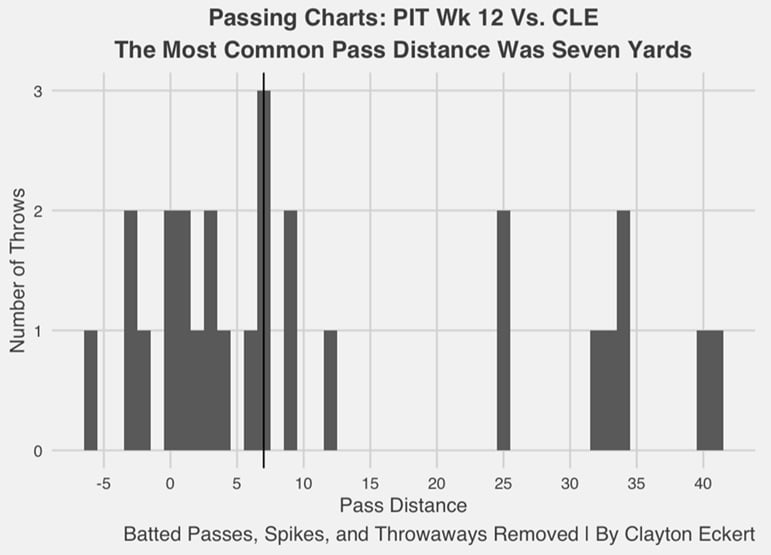
T-1st. Explosive (20-plus air-yards): 29.6-percent. Eight attempts, tying for the most common pass distance. It is a rare occurrence, especially in a bad-weather game. The first example came on drive two on 3rd and 6. Wilson slides right, targeting WR George Pickens deep, making a great catch off his leg, and adjusting to the slightly underthrown ball at 25 air yards and a 31-yard conversion.
Drive three, it’s 3rd and 9. Wilson heaves again for a 40-air yard pass over the middle to WR Calvin Austin, who had to slow up after beating the coverage for the catch and 46-yard gain. If not for the wind, it probably would have been a house call, but it was still a huge double-explosive play.
Just before halftime, he went for a go ball to Pickens, who slowed on his route, then tried to fight through contact, but the pass sailed well past and out of reach on the 33-air yard incompletion.
Second drive of the third quarter, another third down (3rd and 10). Against a favorable zone coverage look, Wilson finds WR Van Jefferson on the go ball between two defenders wide open at 32 air yards, making the catch on the sideline for a 35-yard gain.
With seven minutes left, Wilson wanted Pickens on a deep crosser who beat single coverage in the end zone. Still, the elements seemingly affected accuracy, with the ball sailing way behind him incomplete. Pittsburgh was down 18-13, man.
A couple of plays later, 3rd and 6. Wilson unleashes a dime despite a big QB hit (G Isaac Seumalo failed twist pickup) to Austin, running a slot post to the end zone and making a great contested catch for the go-ahead TD! Score 19-18 with 6:15 left.
You guessed it: another money down (3rd and 4), 3:34 left, same score. Needing to possess the ball/run the clock, seemingly that’s the plan as Fields is in. Instead, a low percentage 34-air-yard deep ball with the game on the line from your quarterback is not the best way to do so in poor conditions. There was lots of contact, but the referees let them play the entire game. Pickens cannot adjust to the ball well outside his back shoulder, and it is incomplete.
A 15-yard shanked punt and Cleveland score followed, down 24-19. Gut-wrenching.
The final example was the game’s last play, with six seconds left. It’s a Hail Mary heave from the 35-yard line, but no Pittsburgh receiver attempts to make a play on the ball. WR Mike Williams and Pat Freiermuth don’t press the issue, and Pickens mixes it up with the DB out of the end zone. Not good, Bob.
T-1st. 0-5 air-yards: 29.6-percent. Typically, it is most common. It’s also true for a play Pittsburgh likes early and often. Play-action boot right, hitting TE Darnell Washington in the flat at the 1-air yard, forced missed tackle, and churn for six yards. In the next play, in 2nd and 4, Wilson goes out route to Pickens for a three-yard gain.
On drive two, Pittsburgh faced 3rd and 6. Wilson surveys and hits Jefferson on the crosser short of the sticks (3-air yards), tackled quickly, and noted routes being too close as Freiermuth was in the neighborhood, making for easier coverage on the fail.
Late first quarter, this 2nd and 6 Wilson was forced to roll left, hitting Washington in the flat (2-air yards) and four-yard gain. Unfortunately, he missed Freiermuth wide open downfield for who knows how big of a play.
In the second quarter, Pittsburgh faced 3rd and 10. Wilson surveys downfield, but the pocket collapses around him and checks it down to RB Jaylen Warren at the line of scrimmage. Only able to muster three yards on the FG settle.
A couple of drives later, it’s a similar pressure situation. Wilson’s forced to step up in the pocket (T Broderick Jones), avoiding a sack as he simply gets rid of it towards Warren. It’s hard to tell if he was trying to throw it away on the near interception. Eek.
Fourth quarter, 2nd and 3. Play-action roll right from Wilson, dumping it to Harris at the line, who slips but provides great YAC on the ten-yard gain. This got Pittsburgh to the five-yard line and ultimately led to a TD drive (Warren three-yard TD) when they were down 18-6.
Last example, 50 seconds left, down 24-19. Wilson chooses a leak out from Freiermuth at 3-air yards but stays in bounds with tons of time coming off the clock. I get saving the timeout, but didn’t seem urgent enough.
#3. 5-10 air-yards: 22.2-percent. Six passes. Third drive, Steelers face 3rd and 6. Wilson steps back, making a decisive thread of the needle pass to Freiermuth on the slant, making the catch against trail coverage. He gets past him upfield, adding nice churn at the end for good measure for the 22-yard gain. Nice.
Later same drive, it’s 3rd and 2. With the pocket collapsing, it’s another nice throw and slant to Pickens, who makes a great contested catch for another conversion of seven yards. Really eating on slants, something I’ve clamored for more of.
Late third quarter, it’s 4th and 1. Despite T Dan Moore allowing pressure and taking a huge hit, Wilson is able to extend the play, and Freiermuth works back to him for the 9-air yard catch and gain to the red zone. Well-timed mini-bye with all the hits Wilson is taking, just 1-of-3 fourth down conversions, great play, and toughness.
Same drive, 3rd and 13, following a Wilson forced fumble (C Zach Frazier bad snap, free rusher). He takes the short target to Pickens at just 7-air yards, where he’s tackled. FG settle, closing the deficit to 10-6.
Next was another 7-air yard target on a two-point conversion. Pittsburgh had just claimed the 19-18 lead, trying to make it a three-point game. The call is a fade route, but not the target you would usually expect with RB Cordarrelle Patterson. Debatable hold, with the pass sailing over his head and out of bounds. Frustrating choice.
Last example, 10 seconds left. Wilson hits the wide-open Austin along the sideline at 7-air yards, gaining nine and out of bounds for a more manageable last play unanswered prayer.
#4. Behind-the-Line: 14.8-percent. Four plays. Second-quarter screen on 2nd and 13 to Harris, with nice blocks out in front (guards Isaac Seumalo and Mason McCormick). Slipped, though, limiting the gain to just three yards darn.
It’s 3rd and 7 early in the third quarter. Wilson faces a free rusher, lobbing it over him to Warren in the flat with a nice churning effort to contort toward the marker. Initially marked a first, that tease then changed to a six-yard gain on the failed drive.
Early fourth quarter, the 1st and 10 is an interesting wrinkle, Washington split out wide taking the WR screen. Tries to hurdle, not clearing the defender in his highlight fashion, but does work forward for four yards.
Twenty-three seconds left, 3rd and 1, but Wilson dumps it to Warren, a huge drive extension on the 11-yard gain, taking their final timeout with some hope. As you know, to no avail.
#5. 10-15 air-yards: 3.7-percent. Just one. With 40 seconds before halftime, Wilson goes to Freiermuth, who ran a post from wide-out alignment, making the grab over the middle at 12-air yards, along with a nice churn to pick up 19.
N/A. 15-20 air-yards: 0.0-percent. NONE.
Here are the dots of completions/incompletions for the game:
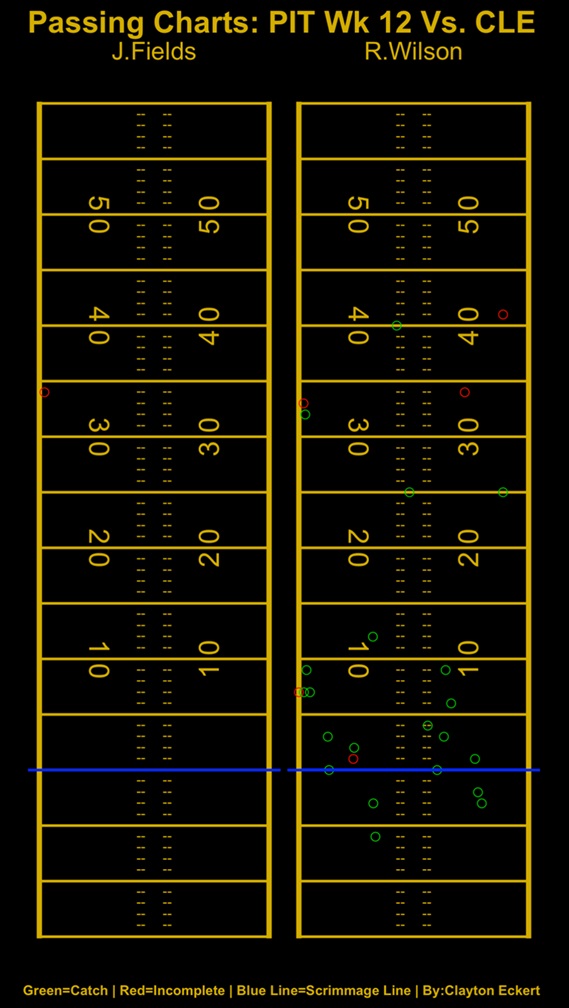

First, we can see Fields’ lone attempt, the explosive incompletion to Pickens. Then, Wilson was highly accurate at 12 air yards or less. Also connected down the field respectably and often despite rough weather conditions.
Just an intermediate throw, over the middle to Freiermuth. Between the numbers was used more often and successfully, including two with explosive air yard targets and a TD to Austin. Only five charted incompletions, three past 30-air yards.
Completion Rates By Distance:
WILSON:
Behind-the-line: 4/4 (100-percent).
0-5 air-yards: 7/8 (87.5-percent).
5-10 air-yards: 5/6 (83.3-percent).
10-15 air-yards: 1/1 (100-percent).
15-20 air-yards: 0/0 (N/A-percent).
Explosive: 4/7 (57.1-percent).
Great rates overall, all above 80 on non-explosives, and past 20 yards was better than his season average on high volume. I’ll include Fields’ lone Week 12 attempt in the season breakdown.
Completion Rates By Location:
WILSON:
Outside left numbers: 6/9 (66.7-percent).
Left numbers-left hash: 5/5 (100-percent).
Inside hashes: 1/1 (100-percent).
Right hash-right numbers: 5/6 (83.3-percent).
Outside right numbers: 4/5 (80.0-percent).
The passing game has trended positively on and between the numbers, with high completion rates in the past two games. The Week 12 difference was adding much more air yardage, which I’ve been clamoring for, and thankfully, Wilson took those opportunities when there. Most issues outside the numbers continue, where Wilson has preferred to throw, particularly to the left.
Now for the heat maps for charted-passes, then completions only:
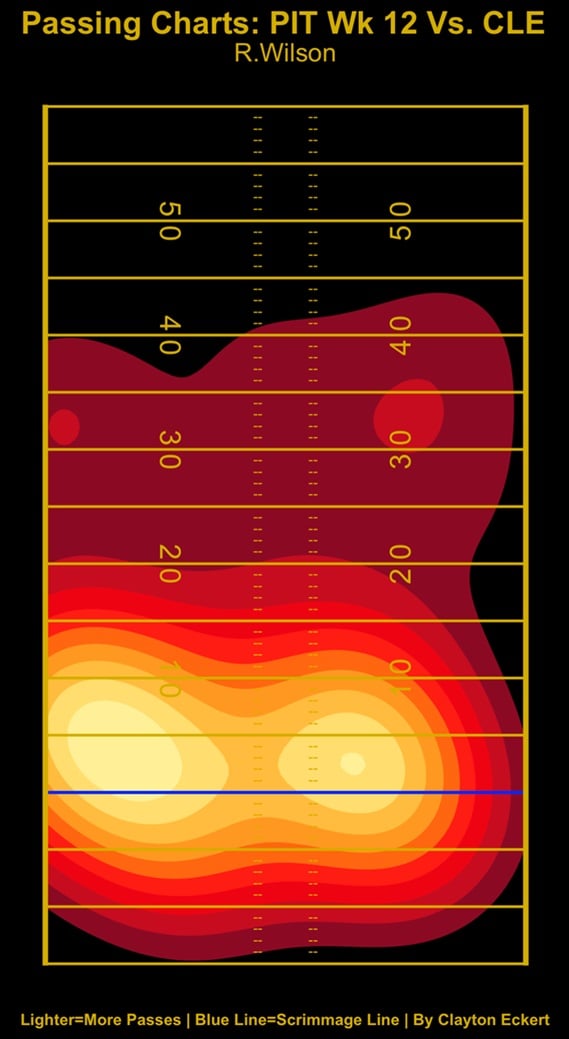

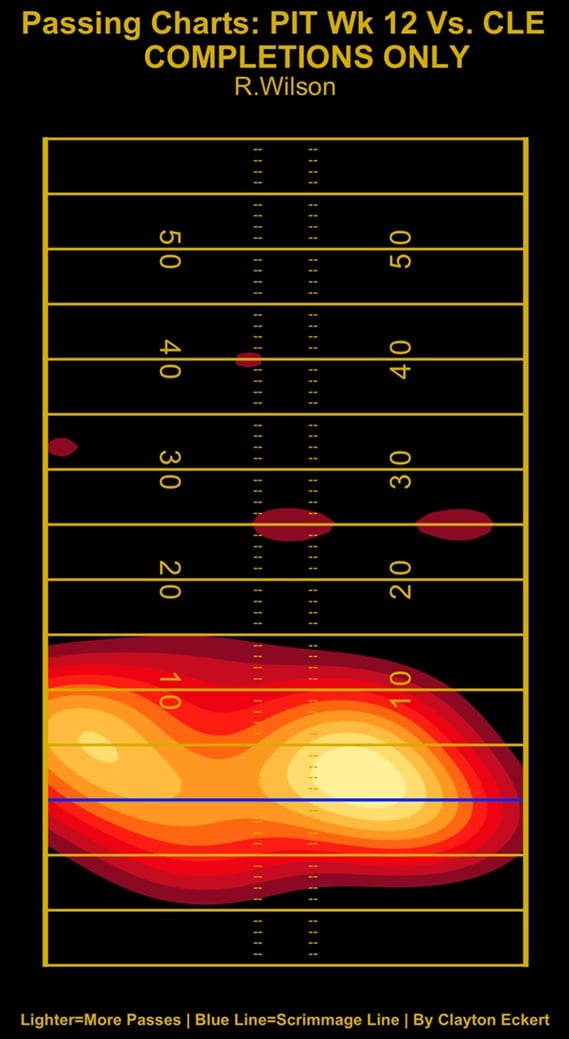

Seeing this much “heat” on both charts is fantastic. With only one intermediate attempt, and such high frequency at ten or less, and explosive air yards, the charted heat map is quite generous coloring that whole area. The completions only view is a reminder, though it was a lack of quantity rather than quality.
Next, here’s Wilson and Fields’ 288 charted throws of the 2024 regular season:
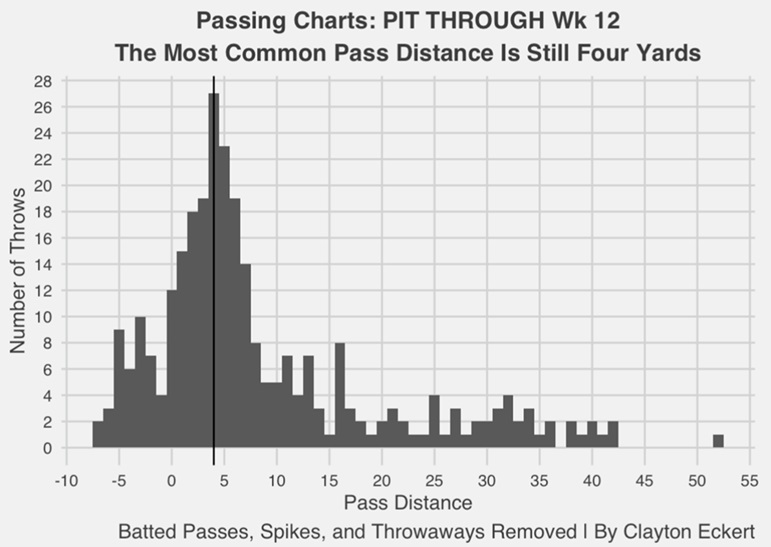

#1. 0-5 air yards: 39.6-percent. Previously 40.6-percent. 2023 35.0-percent.
#2. 5-10 air yards: 25.7-percent. Previously 26.1-percent. 2023 23.8-percent.
#3. Explosive: 16.0-percent. Previously 14.6-percent. 2023 12.4-percent.
#4. Behind-the-line: 14.2-percent. Previously 14.2-percent. 2023 18.5-percent.
#5. 10-15 air yards: 9.4-percent. Previously 10.0-percent. 2023 13.0-percent.
#6. 15-20 air yards: 5.9-percent. Previously 6.5-percent. 2023 10.8-percent.
Explosives skyrocketed by nearly 1.5 percent. In fact, it was the only increase to season averages this week. Behind the line stood pat while every other distance down ticked 0-5 by a full percentage point (typically the most common pass distance).
WILSON:
Behind-the-line: 18/21 (85.7-percent).
0-5 air-yards: 39/49 (79.6-percent).
5-10 air-yards: 20/32 (62.5-percent).
10-15 air-yards: 5/11 (45.5-percent).
15-20 air-yards: 4/8 (50.0-percent).
Explosive: 13/25 (52.0-percent).
FIELDS:
Behind-the-line: 15/20 (75.0-percent).
0-5 air-yards: 57/65 (87.7-percent).
5-10 air-yards: 30/42 (71.4-percent).
10-15 air-yards: 8/16 (50.0-percent).
15-20 air-yards: 5/9 (55.6-percent).
Explosive: 6/21 (28.6-percent).
Here, we see the context to Wilson’s substantially better explosive connection (52 percent), with Fields at 28.6. Yes, part of bringing Fields out for read-option packages needs to threaten to pass. But not a third-and-4 deep shot in fourth-quarter comeback attempts. Wilson has that experience and resume. Fields has the better rates at less than 20-air yards, with the exception of behind the line. I’d stick with that in those situations.
Completion Rates By Location:
WILSON:
Outside left numbers: 28/47 (59.6-percent).
Left numbers-left hash: 24/29 (82.8-percent).
Inside hashes: 3/7 (42.9-percent).
Right hash-right numbers: 20/24 (83.3-percent).
Outside right numbers: 21/30 (70.0-percent).
FIELDS:
Outside left numbers: 35/53 (66.0-percent).
Left numbers-left hash: 14/20 (70.0-percent).
Inside hashes: 11/13 (84.6-percent).
Right hash-right numbers: 26/33 (78.8-percent).
Outside right numbers: 20/31 (64.5-percent).
Wilson continues to fare best between the hash and numbers on both sides of the field. His most frequent is outside the left numbers, but he has the second-lowest completion rate. Inside the hashes is his lowest rate and less frequent by far. Small area of the field, though still notable, compared to Fields’ success and their game totals nearing each other (Wilson five, Fields six).
To close, here are the dots along with heat maps for all charted attempts and completions only:
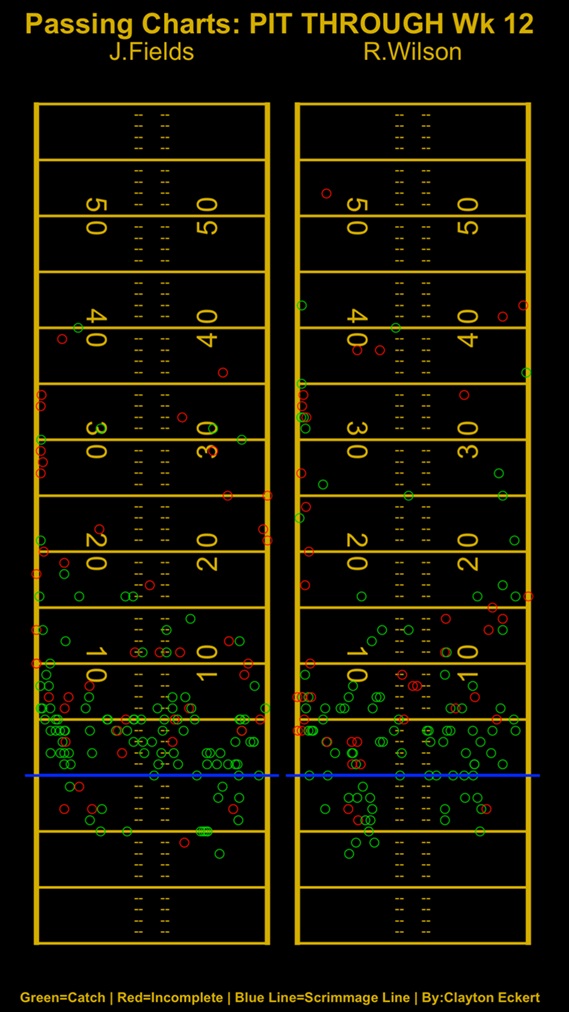

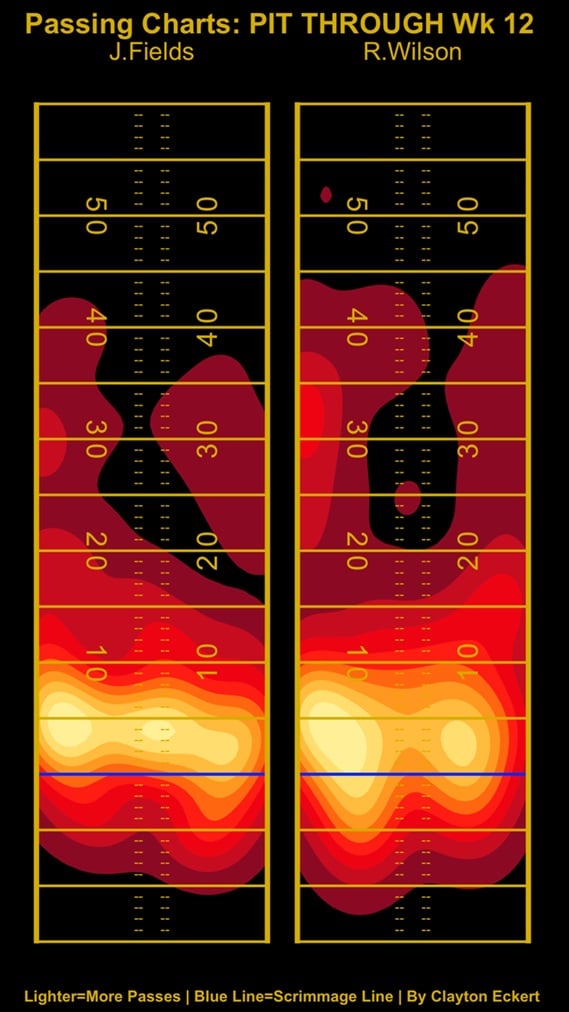

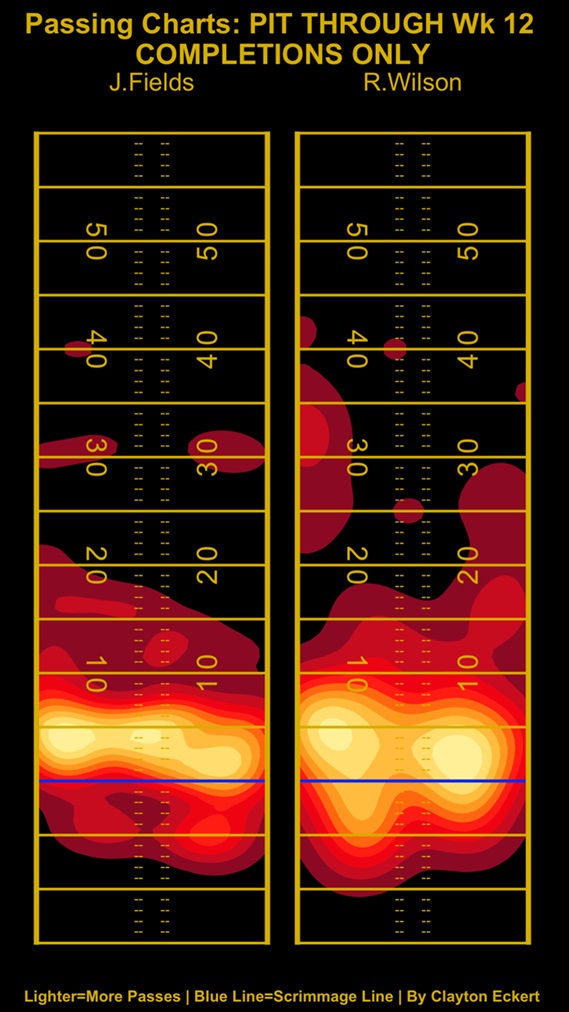

We’re starting to get a more accurate and clearer picture of Wilson’s more varied success with the sample sizes evening out. Here’s hoping it equates to getting back in the win column in a third-straight divisional matchup next game against Cincinnati.
Thanks for reading, and let me know your thoughts in the comments.















